Dave Eggers’ The Eyes and the Impossible was announced this past week as the winner of this year’s Newbery Medal for children’s literature, an award handed out by a division of the American Library Association.
I was delighted by this news because Dave Eggers has been a friend for better than 25 years and The Eyes and the Impossible, the story of the life of a dog named Johannes, told in Johannes’ voice as he serves as the “eyes” to a small heard of buffalo in a city park near the ocean is a really great book.
When young writers ask me the key to getting started in a career, I sometimes joke that if they can make sure to fall in love with the high school friend of someone who will go on to be one of the most dynamic literary people of your generation, it’s a good start. While we both attended the University of Illinois at the same time, it wasn’t until post college that I first spent quality time with Dave at a wedding of a mutual high school friend of his and my wife’s (before Mrs. Biblioracle and I were married). This was not long after he’d started McSweeney’s Quarterly and its associated website, and while he was finalizing the manuscript that would become A Heartbreaking Work of Staggering Genius.1
We had a lot in common in terms of background and taste in literature, music, etc… It made sense that I’d send him some of what I was working on and he liked it. Getting a couple of pieces up on the McSweeney’s website helped me break through at other places, most notably Modern Humorist, which led to my first book, My First Presidentiary, co-authored with Kevin Guilfoile, who I first met because we were both contributing to the McSweeney’s website, and with whom I’ve been bouncing commentaries for this year’s Tournament of Books back and forth with just this week.
When Dave had an overflow audience for an event at the Chicago Public Library he invited Kevin and I to “open” for him with a brief slide presentation from our book. I don’t think I’ve ever stood in front of as many people at one time since.2
When the McSweeney’s website needed an editor, I was handy and ended up working on it in some form or another for a decade. (Maybe longer, I don’t feel like checking right now.)
I have a vivid memory of walking around the San Diego Zoo with Dave on the weekend of that wedding and him asking me if I knew the work of this short story writer, George Saunders, and his first book Civilwarland in Bad Decline.
I had a copy of the book in my backpack that I’d brought on the trip from Chicago.
I didn’t intend this to be John’s trip down memory lane as I drape myself in the sweet scent of nostalgia, but sometimes stuff happens like your friend winning a Newbery Medal, and you can’t help sort of marvel at the things that have happened, the people you spend your life connected to.
Anyway, that intro was just supposed to segue to the main topic I wanted to get to, the year I tried to read every Newbery Medal winning book up to that moment.
That year was sixth grade, 1981-82. I went to grade school at a time and place where “open education” was practiced, meaning individual students could be on different paths, working independently some of the time. Being the little book nerd I am, I’d blasted through the full sequence of language arts textbooks so my teacher (Mrs. Chambers) had to come up with something for me to do. I wound up with two projects, one was tutoring 1st and 2nd graders on reading. (I taught them phonics.)
The other was to read every Newbery Medal book in the school library and write something about each one.
The Newbery Medal stretches back to 1922 (Hendrik Willem van Loon’s The Story of Mankind), but the oldest winner I remember reading that year was Johnny Tremain by Esther Forbes.
Johnny Tremain remains in print today because it rules. The titular character is a teenage apprentice silversmith who is deliberately injured by a jealous rival, leaving him having to make his way through a series of menial jobs working around his crippled hand. He’s briefly jailed after being falsely accused of being a thief and ultimately starts delivering what would become a pro-revolution newspaper, participates in the Boston Tea Party, and at the end of the book, agrees to a surgery to repair his hand so he can properly fire a musket at the Redcoats.
I’m pretty sure I didn’t care about the history embedded in the story at the time I read the book. It was a great adventure story with a plucky hero not much older than I was at the time I read it.
1961 winner Island of the Blue Dolphins by Scott O’Dell was another indelible favorite, the story of Karen, a young indigenous girl who is left behind on an island, initially with her brother who is killed by a pack of feral dogs. She has to survive on her own, ultimately taming one of the feral dogs who becomes her companion. Apparently it’s based on a true story. I think it’s probable that the book has some questionable material by today’s standards v. 1961 in terms of its portrayal of indigenous lives through the lens of the author, but in hindsight, it strikes me as rather feminist in its story of a young woman capable of survival and self-determination.
From 1968 on is when the medal-winning books hit the sweet spot in terms of the book that would significantly define my childhood reading. From the Mixed-Up Files of Mrs. Basil E. Frankweiler by E.L. Konigsburg was the 1968 medalist, and I must’ve had read it twenty times fantasizing about doing something like Claudia Kincaid, the novel’s protagonist, who runs away from home (taking her younger brother, Jamie, with her), taking residence in the New York Metropolitan Museum of Art.
The central action is around the provenance of a mysterious statue that’s connected to be from Mrs. Basil E. Franweiler and Claudia and Jamie get busy trying to solve the mystery. Funny, inventive, wise. What a book.
Sounder by William H. Armstrong was the winner in 1970 and it’s the most wonderfully sad book involving a dog since (or maybe including) Old Yeller. Mrs. Frisby and the Rats of NIMH by Robert C. O’Brien (1972 winner) is about genetically enhanced lab rats that escape and set up a human-like society and come to the rescue of Mrs. Frisby, a mouse who is going to lose her children and home to the expansion of a farm’s fields. I was initially not allowed by my mother to read Julie of the Wolves by Jean Craighead George because of a scene of attempted rape. Little did she know that within a couple of years I’d be sneaking The Clan of the Cave Bear (Jean Auel) which is almost nonstop Neanderthal sex and sexual assault off the shelves.
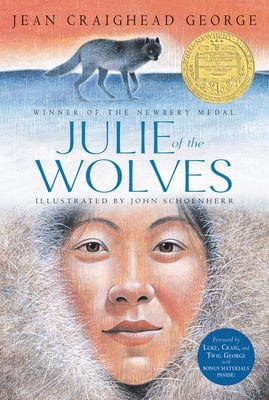
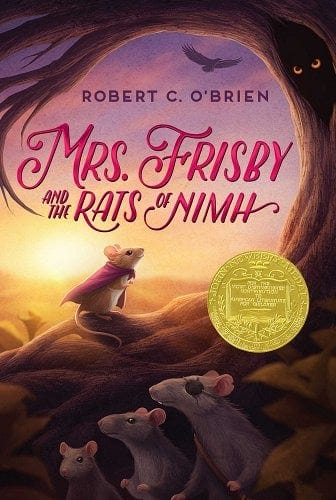
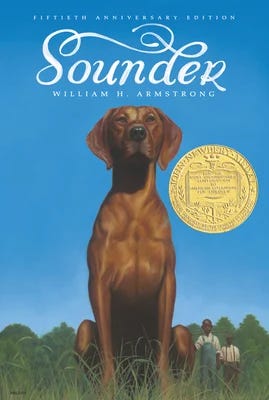
1976 winner The Grey King is part of The Dark Is Rising series that I went out on a limb and declared superior to Harry Potter last year.
1978 winner The Bridge to Terabithia has quite possible affected me as much or more than any book I’ve read in my entire life. I wrote about how the book gave me my first experience of grief, and insight into the importance of view women as equals in a previous newsletter.
The Westing Game by Ellen Raskin (1979) is one of the best mystery novels for a reader of any age ever, period, end of story.
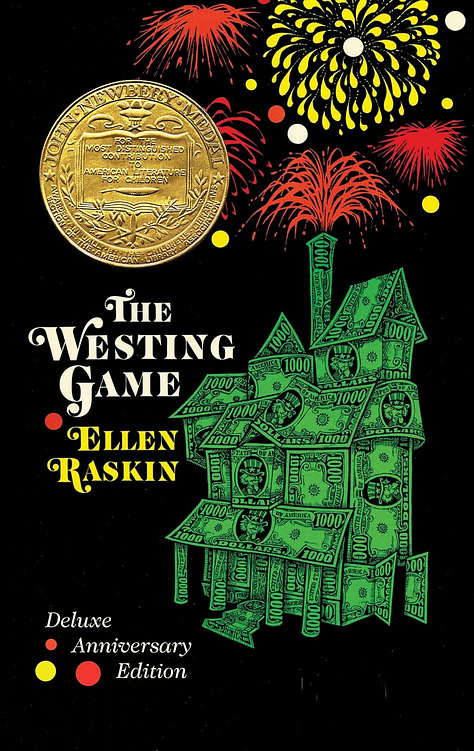
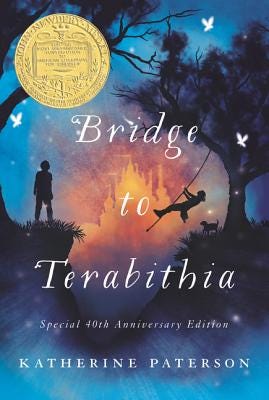
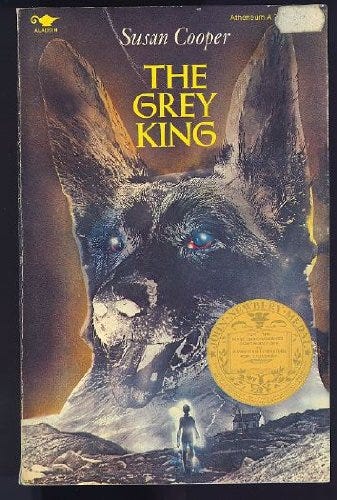
By my memory, and checking against the list of Newbery medalists, I read something like 15 or 20 books for language arts that year. I probably tripled or quadrupled that with my self-directed reading at home. Two books a week was not unusual for me at the time. Meanwhile, as I wrote last year, many students may go their entire school year without reading a full text, as the curriculum is boxed-in by the demands of top-down assessment and standardization.
I was not a brave or adventurous kid by any stretch, but reading really did give me access to the world.
I stopped reading Newbery books pretty much as soon as I hit middle school, which is when I started in on adult spy and thriller novels like the works of Fredrick Forsyth (The Odessa File) and Robert Ludlum (The Bourne Identity). Once I hit adult books, I guess I didn’t look back. The Eyes and the Impossible is the first Newberry Medal winning book I’ve read since I was thirteen- years-old.
I’m probably missing out on some pretty good stuff.
Who can tell me what I’ve missed from the Newberry pantheon?
Links
In my Chicago Tribune column this week I share five of my favorite books about bookstores.
This is a very strange story. Win McCormack, the founder of Tin House Books was allegedly defrauded of nearly $40 million by his chauffeur.
The National Book Critics Circle has announced the finalists for their 2023 publishing year prizes with categories in autobiography, fiction, nonfiction, criticism, biography, poetry, and books in translation. Judy Blume is going to get a lifetime achievement award too.
The New York Times recommends these nine new books this week. LitHub has 26 books that were released this past week.
This essay from legendary critic Greil Marcus on why he writes reflects many of the sentiments I wrestled with in last weekend’s newsletter about consideration v. consumption.
At Inside Higher Ed this week I argued that an algorithm that cannot read, think, feel, or communicate with intention should not be used to teach or tutor writing. I also did another set of Wednesday reading recommendations in case you missed them.
If you’re interested in more on The Eyes and the Impossible, I recommend this podcast episode with the incomparable Brad Listi.
My old friends and McSweeney’s share a piece by Evan Waite which has the painful ring of truth when it comes to the experience of trying to promote one’s book, “As I Say in My Book.”
Recommendations
1. West Heart Kill by Dann McDormann
2. Erasure by Percival Everett
3. Wavewalker by Suzanne Heywood
4. The Scholomance Trilogy by Naomi Novik
5. Vera Wong's Unsolicited Advice for Murderers by Jesse Q. Sutanto
Rachel L - Stoughton, MA
This is a challenging list with not a lot of continuity to get a hold of. In her request Rachel said she likes a book that takes charge from the start, so I’m going with that and recommending Megan Abbott’s The Fever.
1. The Custom of the Country by Edith Wharton
2. The Vulnerables by Sigrid Nunez
3. At the Edge of the Woods by Kathryn Bromwich
4. At Bertram's Hotel by Agatha Christie
5. From Heaven to Arcadia : The Sacred and the Profane in the Renaissance by Ingrid D. Rowland
Mary Ann B. - Wheeling, IL
Here’s a book I hadn’t thought of in a while, but recently unpacked from a box in storage and leapt to mind as a good bet for Mary Ann, The Virgins by Pamela Erens.3
I’m always accepting requests for recommendations. See the link for submitting your list of recent reads.
Okay, that’s enough of old home week, but I have a hunch that I’m not the only reader out there who marks time by the books they’ve read. I still have a specific shelf of books that may seem to have no organizing principle from the outside, but are simply all the books I read in graduate school.
I try not to get too carried away with the idea that reading books is good for you in the universal sense - books are not medicine - but reading books is good for me.
Hoping to have time to get to more bonus recommendations on Wednesday.
JW
The Biblioracle
If you can lay your hands on a paperback edition of AHWOSG that contains the flip side addendum to the original title, “Mistakes We Knew You Were Making” you can read a brief description of my and Mrs. Biblioracle’s wedding. I am identified by the pseudonym Philippe de Beethenboton (or something like that).
There were some other adventures too, one involving a trip to Toronto with Kevin, and the writer Neal Pollack for an event which included an on-stage interview between Dave and a guy in a Wolverine (X-Men) costume, and not the cool Hugh Jackman look. Another event involved Ira Glass making balloon animals. All 100% true.
All books (with a couple exceptions) linked throughout the newsletter go to The Biblioracle Recommends bookstore at Bookshop.org. Affiliate proceeds, plus a personal matching donation of my own, go to Chicago’s Open Books and an additional reading/writing/literacy nonprofit to be determined. Affiliate income for this year is $1.70.

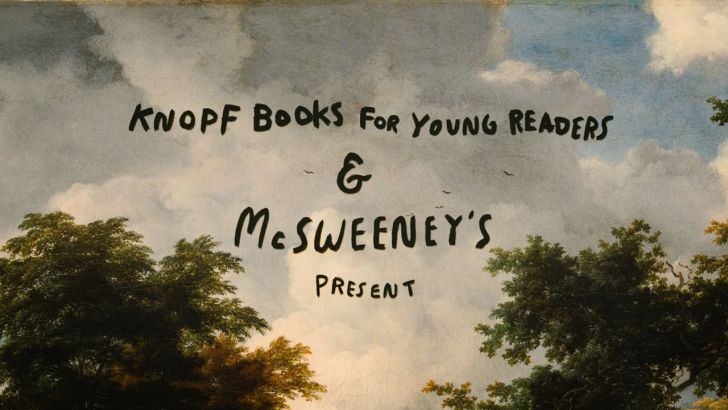



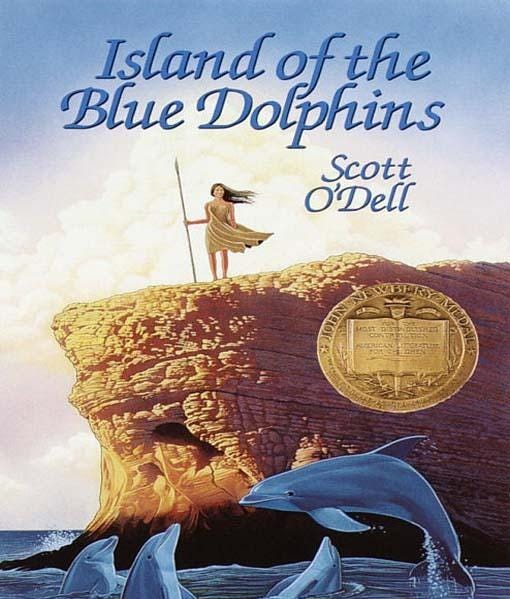
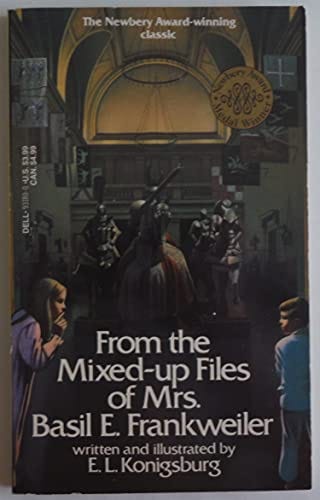
As a middle school librarian, I DEFINITELY have thoughts! And love a lot of the recent Newbery winners, and also tend toward the ones I would have loved in my youth:
- 2023 was "Freewater," a book about two enslaved children who escape and enjoy a hidden community in the Great Dismal Swamp. (Definitely would have been into this as a youth - secret community in the woods? Yes please!)
- In 2022, Donna Barba Higuera's "Last Cuentista" might be one of favorite books of the past couple of years, period. It is a sci-fi novel where space ships are taking humans from earth to an inhabitable place. The people "in charge" try to erase memories and stories, and our protagonist ("The Last Cuentista") is able to hold onto memories and retell the stories. It is a beautiful book about the importance of story and memory. She has a brand-new book this year that takes place in the same place/time - only back on earth. It is called "Alebrijes," and I might even enjoy it more. I also love the liberal use of Spanish in both of these books. (I feel like I am giving a book report now, but I obviously love these two).
- 2021's "When You Trap a Tiger" by Tae Keller is magical realism - which is my jam. A biracial girl and family move in with their grandmother, and she begins learning about Korean folklore from her. I love books with grandparents (probably because I loved my own grandparents so dearly!).
- 2020's win was a historic one - the first graphic novel, Jerry Craft's "New Kid," which follows Jordan Banks as he enrolls in a private school. He is one of the few Black kids there, and feels out of place at school and in his home community. It is a great balance of real feels and humor. (There are also two sequels to this now, both of which are similarly great).
Other more recent ones I enjoyed include:
- "Last Stop on Market Street" by Matt de la Pena (a truly great picture book about a boy and his grandma taking a ride to ... somewhere on a bus);
- "The Crossover" by Kwame Alexander (a novel in verse about twin brothers who play basketball, which plays with poetry in a fun engaging way, and is one of the most readable books ever for students that "don't like to read"); "Bud not Buddy" by Christopher Paul Curtis (an author who just won the CSK Virginia Hamilton Award for lifetime achievement - the book takes place during the depression era and sees Bud riding the rails and visiting a Hooverville after escaping a terrible foster family, and was the first book to win both the CSK and Newbery),
- "The Graveyard Book" by Neil Gaiman (about a boy raised by ghosts in a graveyard after his family is murdered, which includes Gaiman's warmth, but also is truly creepy, which is all my middle schoolers truly want);
- "The Tale of Despereaux: Being the Story of a Mouse, a Princess, Some Soup, and a Spool of Thread" by Kate diCamillo (which plays like a fairy tale, and involves a very brave mouse who tries to save a princess ... but is so much more than an actual fairy tale);
and finally, "Holes" by Louis Sachar, another amazing story with magical realism, which is still HUGELY popular despite being published in 1998 (which is eons ago for my youth). It is the story of Stanley Yelnats, a habitually unlucky child who accused of stealing a pair of famous sneakers and sent to a correctional boot camp in the middle of the desert to dig holes. It is truly delightful.
I've got a few years on you, but I remember paying attention to the Newberry winners as a kid and also a bit when my sons were kids. The two standouts for me (and at my time) that you missed were A Wrinkle in Time (how many times have I read it? good question! Oh, Meg, Oh Calvin, Oh Charles Wallace!) and also Summer of the Swans. I'm still a big fan of the Mixed-Up Files and also dreamed of having a similar adventure, and I'm sure we aren't the only ones!